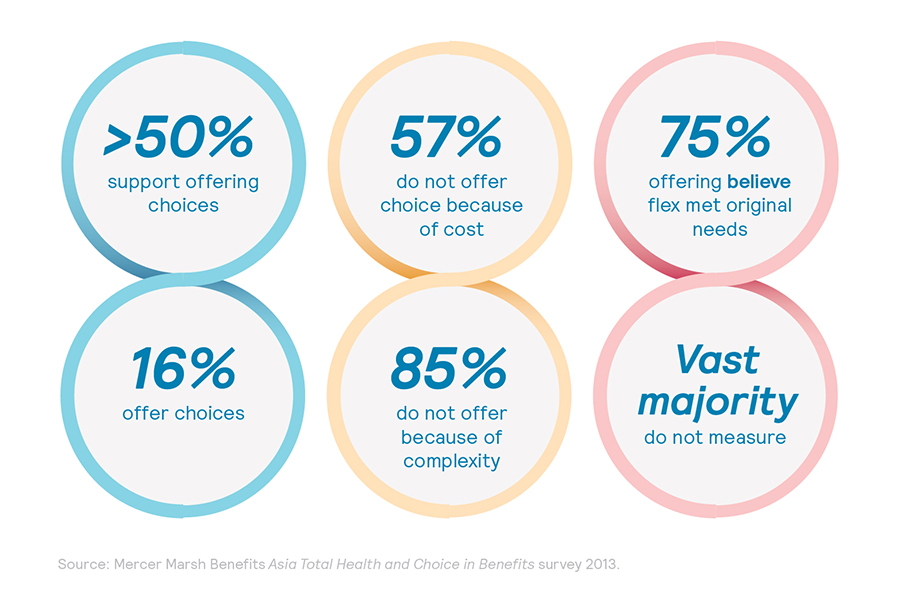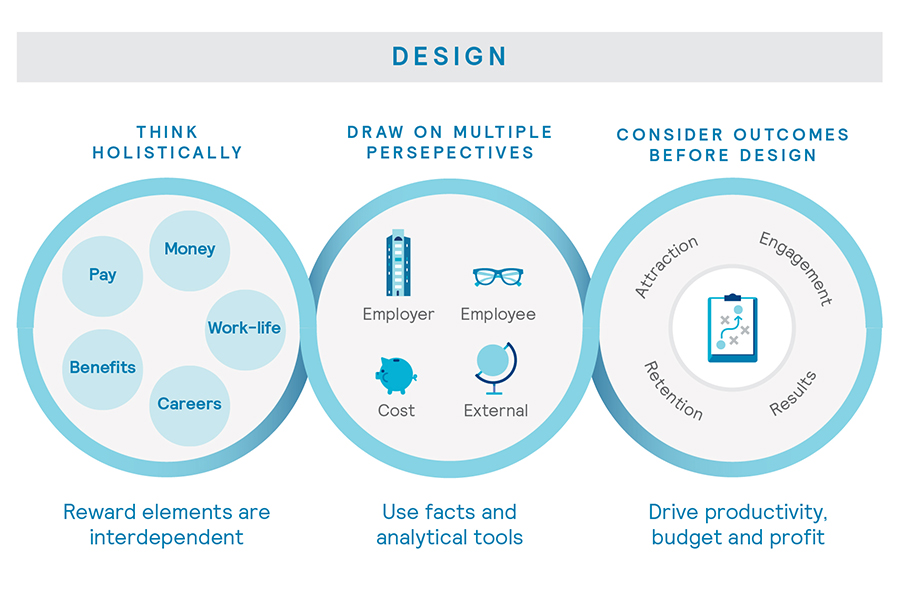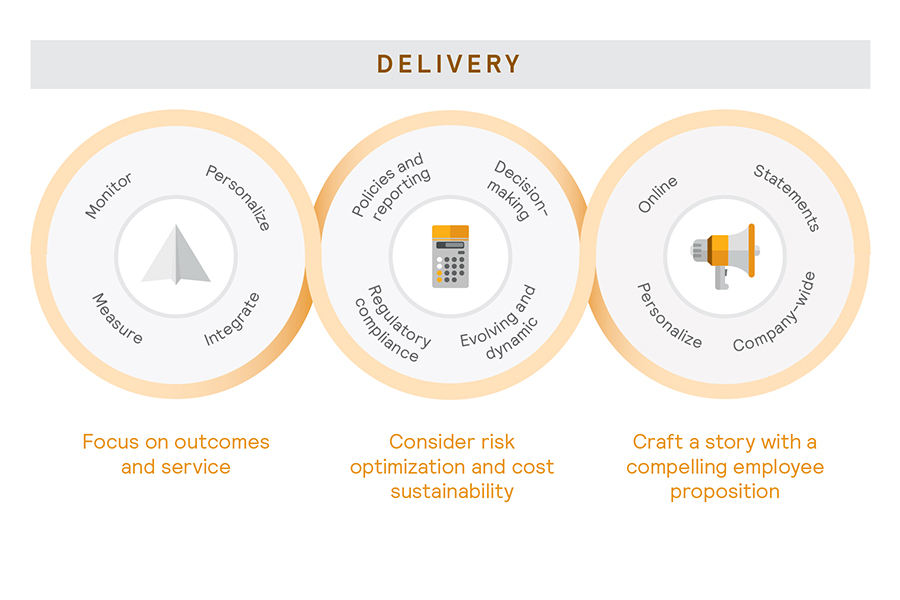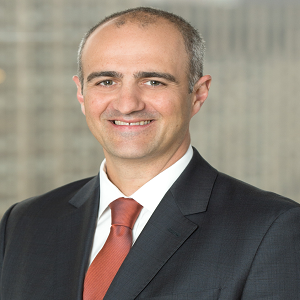“Flexible Benefits means offering employees choice through effective design, delivered via engaging portals, promoted with unique branding & communications.”
How Do You Define Flexible Benefits?
Many employers in Asia view flex as a complicated and difficult-to-administer benefits structure delivered through an expensive portal. This definition of flex programs is no longer correct.
Today, “flexible benefits” means offering employees choice through an effective design, delivered via an engaging portal and promoted with unique branding and communications. Flexible benefits can be as simple and straightforward as offering employees the choice of two or three fixed benefits packages or voluntary top-up benefits. Even cash is a form of choice.
Why Flex?
The implementation of an effective flex program can be an affordable way for employers to increase the value of benefits while offering options that can easily be tailored to fit diverse employee profiles, needs and life stages. Such programs can increase the value of benefits at no additional cost, fill gaps in employer-paid benefits and build corporate branding through increased engagement. From an employee perspective, flex allows individuals to select the benefits features that best suit them and their families. In more mature markets, such as the United States, United Kingdom and Australia, the flex concept has been used to this effect for some time.
Are Flexible Benefits Working?
Based on the 50 percent of employers say they support offering choices, yet only 16 percent actually offer them1. Although some employers may be tempted to consider implementing flex, the vast majority choose not to because of the perceived complexity. Thus, despite maintained interest, flex plans in Asia are not picking up momentum.
Perception Versus Reality

The unfavorable opinion toward flexible benefits programs in Asia is perpetuated by the fact that few employers use tangible metrics to evaluate their programs.
Why Are Flex Plans Failing Asia?
Flexible benefits programs can be simple and effective but have not actually been
successful in engaging employees because of four key pitfalls:
- 1. Too much choice: Existing choice programs struggle to achieve success because they offer too many choices with too little differentiation. This compounds administration complexity and makes communicating benefits difficult. The value of the benefit is lost on employees as they struggle to understand what’s being offered and what it means for them.
- 2. Designed based on market benchmarking data alone: This means employers are taking an external view only and missing the internal perspective of ensuring the plan supports business goals and meets the needs of their unique employee profile.
- 3. No regular review: Too often, a plan receives only a few tweaks to design and structure over the years. Only comprehensive, regular revision can ensure that the plan continues to meet changing business goals and employee needs.
- 4. No branding and/or communication strategy: The program should be branded to resonate with employees, offer engaging, guided decision-making and be communicated throughout the year using various media.
The Importance of Taking a Total Rewards Approach


With the current talent shortage in Asia, cash is no longer king. Employer focus needs to shift away from compensation alone. But the reality is that many employers are still struggling to see benefits beyond just medical, risk (life and disability) and retirement programs.
Employers need to expand their view of benefits to be all encompassing. Flex isn’t a single component of the total rewards framework but can roll into career, work-life balance, how and where we work (including telecommuting and flexible work arrangements) – event the desks you sit at and the snacks in your pantry.
Steps to Implementing an Effective Flexible Benefits Program
Define Your Goals
For the program to support the business objectives of the organization, it’s important to define what success looks like for you. Is the ultimate objective productivity? Managing your budget? Or people-related goals, such as retention and attraction?
Build a Smart Design
Programs should be designed with an understanding of competitor offerings but also with the employer and employee perspective in mind, including cost requirements and employee demographics. Regulatory requirements must also be taken into account. Use data as evidence to support the process of building an effective design.
Determine Structure and Financing
Once a smart design has been pinned down, how do you effectively deliver the plan? Think through the best structure and platform to deliver your value proposition. This doesn’t have to be via a fancy portal. Where they make sense to promote and showcase the value of the program, you can use existing technology platforms with help from a partner who understands how to maximize employee experience. One of the realities in Asia is that vendor capabilities are limited, so selecting a partner that understands your business and can grow with you into the future is crucial. The cost of the program is also important in this era of increasing cost of care and double-digit inflation. Thinking through the optimal financing approach (for example, self-funded) should not be overlooked.
Develop Unique Branding and Communications
Unique branding and communications are crucial for differentiating your plan and establishing an emotional connection with employees. Look to differentiate yourself as an employer via benefits that are more than just medical- and protection-related. Consider the entire benefits spectrum
and how benefits are delivered and branded. Communication should be simple, targeted and deployed frequently via multiple channels. Ultimately, employees cannot appreciate and understand something they know nothing about, which is why communication is just as important as design.
Despite common perception, implementing a flexible benefits program can be simple, easy to administer and even used as a cost-containment strategy if managed properly. But unique benefits programs also lend another, arguably greater, advantage — differentiation and a way to connect with your employees. To attract the best talent — a necessary strategy as Asia becomes a main player on the world economic stage — organizations have to expand their packages beyond compensation and a basic benefits offering.
1 https://www.marsh.com/ae/en/services/employee-health-benefits.html










